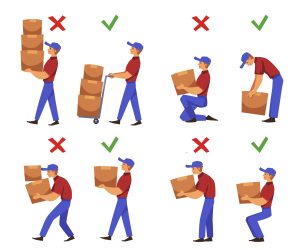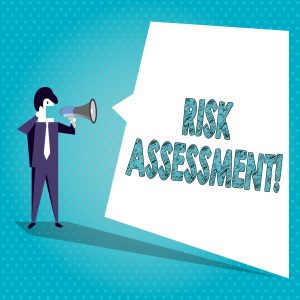In this guide, we examine manual handling injuries and when it is possible to claim for the harm suffered. There are various risk factors that need to be considered when picking up, carrying or moving an object. We’ll look at a few of these and the injuries manual handling incidents can cause.
Additionally, we’ll examine ways your employer can prevent manual handling injuries. While you are at work, your employer must take reasonable and practicable steps to ensure your health, safety and welfare. This is their duty of care as set by the Health and Safety at Work etc. Act 1974 (HASAWA). Part of this duty involves ensuring that employees have appropriate training for the tasks they are expected to carry out. In addition to this, there are further health and safety laws that your employer must adhere to if your work tasks involve manual handling.
If you suffer injuries from manual handling due to a breach of your employer’s duty of care, you might be eligible to claim compensation. This guide concludes with a look at the benefits of having the support of a No Win No Fee solicitor when making a personal injury claim.
Our advisors are available to discuss claims for manual handling accidents. They can also assess whether you have good grounds for a manual handling injury claim, and if you do, you could be connected to one of the No Win No Fee solicitors from our panel.
To speak to an advisor about claiming for injuries from manual handling:
- Call 020 8050 2736
- Fill in our claim online form and an advisor will call you back.
- Ask about manual handling claims in our live chat.
Select A Section
- Manual Handling Injuries In The Workplace
- Risk Factors That Can Impact Manual Handling
- What Are The Most Common Manual Handling Injuries?
- How To Prevent Manual Handling Injuries In The Workplace
- Claim For Manual Handling Injuries Using A No Win No Fee Solicitor
- Resources About Claiming For Manual Handling Injuries In The Workplace
Manual Handling Injuries In The Workplace
The Health and Safety Executive (HSE), Great Britain’s authority for the regulation and enforcement of workplace health and safety, defines manual handling as “transporting or supporting a load by hand or bodily force”, it includes “lifting, putting down, pushing, pulling, carrying or moving loads”. With a load defined as “an object, person or animal”.
Various jobs will involve manual handling. A few examples include:
- Factory work
- Distribution centre
- Shop work
- Working in a warehouse
- Delivery driver
- Manufacturing
- Retail
- Healthcare
This list is not exhaustive but can provide some idea to the industries that require employees to carry out manual handling tasks. If you work in an industry that requires such tasks, training in how to prevent manual handling injuries in the workplace is vital. This training should be relevant to the work role. If you have suffered a manual handling injury while at work and you believe it occurred due to employer negligence, please call our advisors now for a free case assessment.
Risk Factors That Can Impact Manual Handling
As we previously discussed, your employer owes you a duty of care under HASAWA. To comply with this duty, they must adhere to other pieces of relevant health and safety legislation. This includes the Manual Handling Operations Regulations 1992.
These regulations set out additional duties for employers to fulfil if an employee is expected to handle an object, person or animal. They include rules on:
- Avoiding manual handling operations if there’s an injury risk.
- If they can’t be avoided, carry out risk assessments.
- Taking appropriate steps to reduce injury risks.
- Considerations for the weight and centre of gravity for each load.
What Are The Most Common Manual Handling Injuries?
Unsafe manual handling techniques can cause a variety of different injuries. Examples of common manual handling injuries include:
- Back injury. These can be caused by incorrect lifting techniques that put strain on the back.
- Hand injury. These can occur if the correct manual handling procedures are not followed.
- Foot injury. You could sustain a foot injury if an object falls out of your hands and lands on your foot. Injuries could include broken bones and bruising.
- Shoulder injury. These can happen when reaching and stretching too far for an object or if the object is too heavy.
- Neck injury. You could suffer a neck injury if you are lifting an object that is too heavy.
- Sprains and strains. For example, these could occur in your arms and legs if you are lifting and carrying objects that are too heavy.
An advisor from our team can discuss how to claim for manual handling injuries in the workplace and what steps you can take to make a claim if you are eligible.
How To Prevent Manual Handling Injuries In The Workplace
There are various steps your employer can take to help prevent common manual handling injuries. These will typically start with a risk assessment that looks at:
- The load to be moved.
- Environment in which it needs to be moved.
- Employees tasked with doing so.
This may identify ways that injury risks could be reduced. The HSE advises that if providing mechanical lifting aids, such as a hoist, isn’t reasonably practicable, employers could reduce manual handling risks by:
- Smaller, lighter and easier to grasp loads.
- Breaking up larger loads into smaller ones.
- Workplace modifications to reduce carry distance, twisting and the need to lift things either from floor level or above shoulder height.
- Changing the work routine. As previously discussed, injuries could be suffered due to repetitive movements.
- Environmental improvements, such as more space, better flooring and extra lights.
- Provide adequate training to anyone expected to handle objects.
An advisor from our team can go through how to claim for manual handling injuries in the workplace with you.
Claim For Manual Handling Injuries Using A No Win No Fee Solicitor
If you are eligible to make a manual handling claim, you may like to do so with the support of a solicitor. One of the personal injury solicitors from our panel could help with your claim. Generally, our panel provide their services on a No Win No Fee basis, under a Conditional Fee Agreement (CFA).
When your solicitor offers a No Win No Fee service, they:
- Don’t take an upfront fee for work on your manual handling case.
- Won’t ask you to meet ongoing costs.
- Won’t charge for their work if your case fails.
- Take a capped percentage from your award if your claim for manual handling injuries is successful. The law limits the percentage that can be taken as this success fee.
Contact an advisor to learn more about how to claim compensation for manual handling injuries in the workplace. In addition to answering your questions, an advisor can value your claim as well as assess whether you might be eligible for manual handling compensation. If you have an eligible accident at work claim, you could be connected to one of the No Win No Fee solicitors from our panel.
To discuss manual handling injury claims with an advisor:
- Call 020 8050 2736
- Begin your claim online.
- Ask about personal injury claims in our live chat.
Resources About Claiming For Manual Handling Injuries In The Workplace
Here are some extra accident at work claim guides:
- Details about claiming for a serious work injury and how much compensation could be awarded.
- Guidance about the personal injury claims process that needs to be followed to seek compensation.
- Information about the time limit when filing a personal injury claim.
These external websites might be useful:
- Workers’ guidance on health and safety from the HSE.
- Details about claiming statutory sick pay (SSP) from the government, including statutory sick pay rates and how to claim.
- Information about back pain from the National Health Service (NHS).
Please direct any further questions about claiming compensation for manual handling injuries to one of the members of our advisory team.




